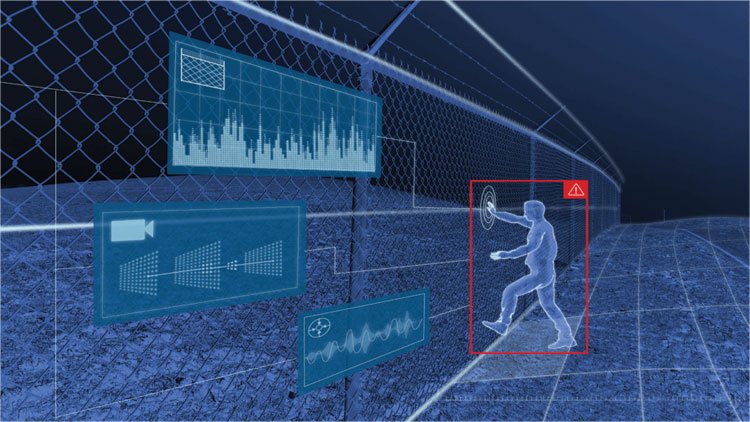In a world where security threats are constantly evolving, perimeter security remains a cornerstone of safeguarding critical infrastructures, commercial properties, and residential complexes. The perimeter serves as the first line of defense, deterring intrusions and delaying unauthorized access. Advancements in technology and evolving security demands have led to a wave of innovative solutions, transforming perimeter security into an intelligent, adaptable, and robust system.
Proactive Approach
The increasing sophistication of threats, including cyber-physical attacks, terrorism, and theft, necessitates a proactive approach to perimeter security. Industries such as defense, utilities, airports, and data centers face unique challenges due to their critical nature and scale, requiring customized solutions. Furthermore, regulatory compliance and the need to protect personnel, assets, and information further amplify the importance of state-of-the-art perimeter security systems.
Recent developments in perimeter security have focused on integrating advanced technologies to enhance detection, prevention, and response capabilities. These innovations include Artificial Intelligence (AI) and Machine Learning (ML), which are revolutionizing perimeter security by enabling systems to analyze large datasets, identify patterns, and make real-time decisions. Modern systems use AI for intrusion detection, predictive analytics, and behavioral analysis, allowing security measures to distinguish between harmless activities, such as animal movements, and genuine threats like unauthorized human entry. Machine learning models predict potential vulnerabilities by analyzing historical data and environmental factors, while AI algorithms monitor and analyze behavior patterns to identify suspicious activities.
Perimeter Intrusion Detection Systems
High-definition cameras equipped with advanced analytics play a crucial role in perimeter security. Innovations such as facial recognition, thermal imaging, and object detection enable systems to identify individuals attempting to breach the perimeter, provide reliable surveillance even in low-light or adverse weather conditions, and detect and track objects like vehicles or drones entering restricted areas. Perimeter Intrusion Detection Systems (PIDS) have also become more sophisticated, combining multiple technologies for enhanced accuracy. These systems include fiber optic sensors that detect vibrations caused by intrusions along fences or buried cables, microwave barriers that trigger alarms upon disturbance, and radar systems that detect movement across large distances, providing real-time alerts.
Traditional fences have been upgraded to smart systems incorporating electrified fences that deliver non-lethal shocks to deter intruders, integrated sensors that detect climbing, cutting, or tampering with the fence, and connected systems that integrate with command centers for immediate response. Drones have emerged as a dual-purpose tool in perimeter security, with surveillance drones patrolling large perimeters to offer aerial views and quick access to remote areas, and counter-drone technology detecting and neutralizing unauthorized drones attempting to breach the perimeter.
Emerging Trends & Technologies
The Internet of Things (IoT) has enabled interconnected security devices, providing seamless communication and data sharing. IoT-enabled sensors provide real-time data on environmental conditions and potential threats, centralized control allows integrated systems to be monitored and controlled through a single platform, and cloud connectivity enhances data storage, analysis, and accessibility.
In addition to technological advancements, several trends are shaping the future of perimeter security. Edge computing reduces latency by processing data closer to its source, which is crucial for perimeter security where real-time responses are essential. The convergence of physical and digital security has led to increased focus on protecting connected devices from cyber threats, with manufacturers embedding cybersecurity features to secure communication channels and prevent unauthorized access. Environmentally conscious solutions such as solar-powered cameras and energy-efficient sensors are gaining traction, reducing the environmental impact and operating costs of perimeter security systems.
Hybrid security solutions combine traditional measures like guards and barriers with advanced technologies to provide layered security, ensuring redundancy and addressing potential blind spots. Modern perimeter security systems also offer detailed analytics and reporting features, providing actionable insights for decision-making, including metrics like incident frequency, response times, and system performance.

Challenges
Despite these advancements, implementing cutting-edge perimeter security comes with challenges. Sophisticated technologies often require significant investment in installation, maintenance, and training, making it difficult for organizations to balance cost with effectiveness. Integrating diverse technologies into a cohesive system can be complex and time-consuming, and ensuring compatibility and seamless operation is essential for effectiveness. Advanced sensors and cameras can occasionally generate false alarms, causing unnecessary disruptions, and calibrating systems to reduce false positives remains a priority. Compliance with regional security and data protection regulations adds another layer of complexity, requiring organizations to stay updated on legal requirements. Security threats are continually evolving, and systems must adapt quickly to ensure scalability and address emerging risks.
Conclusion
As threats become more dynamic, perimeter security systems will continue to evolve. Key future developments include autonomous security systems enabled by AI and robotics, which can detect, assess, and neutralize threats without human intervention. The rollout of 5G networks will enhance the speed and reliability of connected security devices, supporting real-time analytics and faster responses. Biometric technologies like iris and voice recognition will enhance access control, ensuring only authorized personnel can enter secured perimeters. Quantum cryptography will secure communication channels between perimeter security devices, preventing cyber-attacks and data breaches. Organizations will adopt collaborative security ecosystems, integrating data and insights from various sources to enhance situational awareness.
Perimeter security has indeed come a long way from traditional barriers and surveillance methods. Modern systems leverage AI, IoT, drones, and advanced analytics to provide unparalleled protection against diverse threats. As technology continues to evolve, the focus will remain on creating intelligent, adaptive, and sustainable solutions to safeguard people, assets, and critical infrastructures. Organizations must invest in these innovations to stay ahead of potential threats and ensure a secure future.


